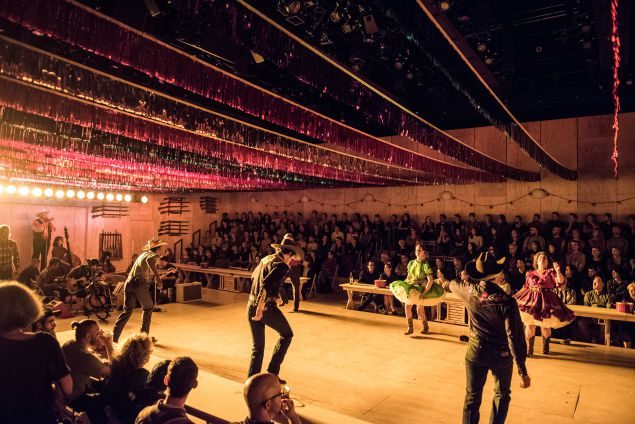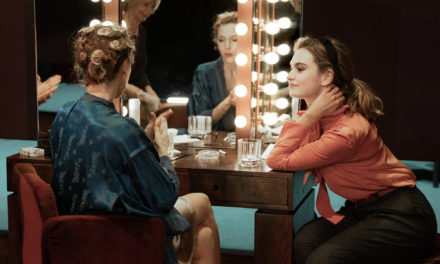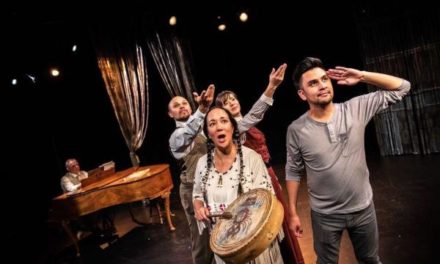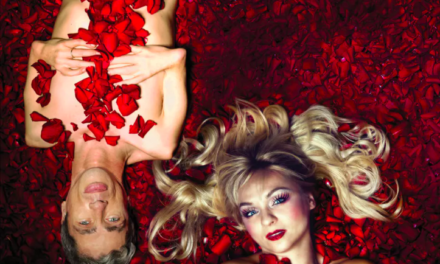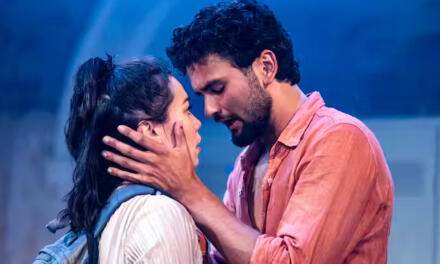Jonathan Kalb: So Jonathan, did you like the show?
Jonathan Kalb: Can we come back to that, Jonathan?
JK: Okay. What did you think of the reinvented environment?
JK: I thought it was inspired. At least the intentions were. You walk into St. Ann’s Warehouse and it looks like a humble western Grange Hall, with bright tinsel bunting across the ceiling and walls of plain blond plywood everywhere. There’s a bland pastel farmscape painted on one side (in the same style as the show’s original sets) and menacing racks of real rifles on the other. The room hints at a passel of wry collisions and contradictions before the music even starts. You’re in a replica of an iconic American communal gathering place with your nose also stuck in the violence that underwrote the creation of such communities.
JK: What about finding such a wholesome, self-consciously “nostalgic” rural habitat installed in the middle of gentrified DUMBO, for the amusement of the urban theatrics?
JK: Are you saying it was insincere? Ironic? I guess we do chuckle at the idea of “nostalgia,” and the nod to those quaint aspirations to social concord behind the pastoral Grange idyll. But does that necessarily mean we sneer at the aspirations? Even cynical “citiots” can still regret the disappearance of places where Americans can gather and feel like one people. It’s probably true that most of us don’t find the question of whether farmers and cowhands can be friends particularly pressing. Nor does pretty Laurey’s indecision over whether to go to the box social with affably melodious Curley or ominously surly Jud Fry set most of us aflutter with anxiety.
Yet the music for this show really is lodged in our bones. As we listen to the songs, most of them nailed with subtlety and conviction by a cast with killer vocal chops—in scaled-down arrangements by Daniel Kluger that emphasize intimacy and folksiness—we actually find ourselves longing to define “we.” We can’t help but ask what this famous composite portrait of aspirational America means to us. Turns out we’re invested in Oklahoma! in ways we don’t sufficiently understand, and Fish’s staging (with Laura Jellinek’s set design) helps us think about that. Most of the St. Ann’s crowd probably comes in vaguely aware that this show used a cartoon Western story set in 1906 to help America pluck up its courage and pride as thousands went off to war in 1943, but they want to know why that still matters.
JK: What did you think of the diverse casting?
JK: I liked it. The diversity itself, that is, not all the performances. Having a Laurey and Curley of different races forced the tale into the age of inclusion. It sent our imaginations and associations wandering across the whole American populace, rather than confining them to the white part that both the original musical and its source play, Lynn Riggs’s Green Grow The Lilacs, presented as the whole. Watching this cast I found myself reflecting on myriad textual and atextual possibilities of what could have been and might still be in farms like Aunt Eller’s and territories like Oklahoma. My biggest smiles came from Ali Stroker’s Ado Annie. Stroker uses a wheelchair, a reality that filtered her character’s story through the lens of disability. Her father’s desperation to offload her, the peddler Ali Hakim’s opportunism in angling for a quick roll with her: all of that took on its own special italics in this production. Especially cool was the strength and canniness of Stroker’s character. Her Ado Annie was in control the entire time. I Caint Say No was pure fun, but also style and strategy in concert.
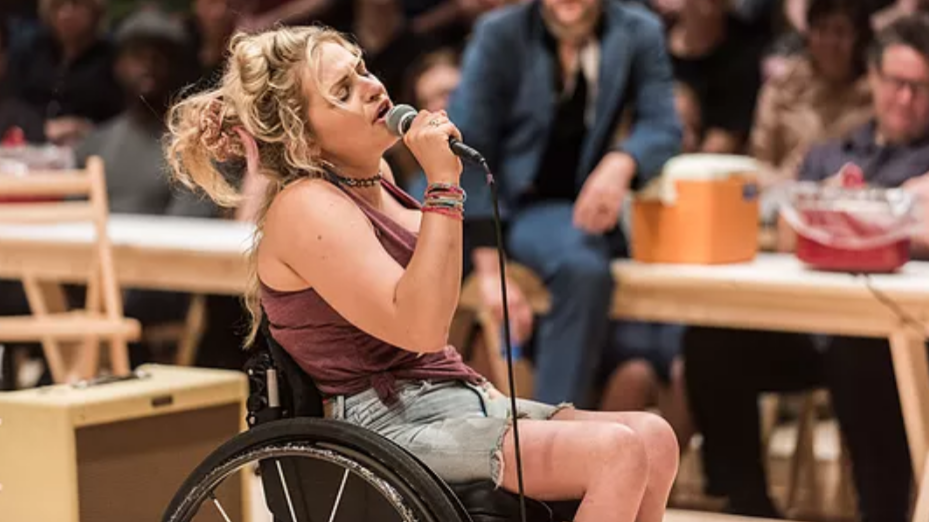
Ali Stoker in Daniel Fish’s Oklahoma! Photo by Teddy Wolff
JK: So what were your reservations?
JK: For one thing, the sightlines were atrocious, which is not a small thing. The playing area was like a mini-football field, a long central aisle with the audience on opposing banks of bleachers. To make that arrangement work, you have to employ the conventions of its Court Masque origins, which means moving players from one end to the other in processions (which needn’t always feel like processions). That’s the only way to make everyone feel included. Here, the 6-piece orchestra was plunked down at one end, blocking all but the most clumsy through-movement there, and the rest of the space was treated as a long thrust, with action played primarily for the benefit of folks at the other end. I was seated beside the orchestra at one of the long tables lining the sides, and I never saw anything but actors’ backs about half the time. It’s a testimony to the power of their pipes that I could tell how good the songs were even though I heard them only after the sound bounced off the walls.
JK: Aren’t you exaggerating? Not every song was so poorly staged that way. Damon Daunno, for instance, the actor of Curly, opened the show with Oh, What A Beautiful Mornin’ walking around playing guitar.
JK: Okay, so that’s true, I enjoyed that, and he did other songs that way too, but they were exceptions.
JK: Anything else, bro?
JK: Yeah, I thought Rebecca Naomi Jones lacked a clear objective as Laurey and had zero chemistry with Daunno. Her singing voice is angelic but she pretty much scowled the whole time and seemed to believe Laurey’s emotions were mostly anger.
JK: But Sarah Larson singled Jones out for special praise in The New Yorker.
JK: [Runs away weeping.]
JK: Wait, come back! There are chili and cornbread!
JK: Of course!—those magical restoratives renowned for their astonishing power to entice people back after intermission even if they couldn’t see half the action.
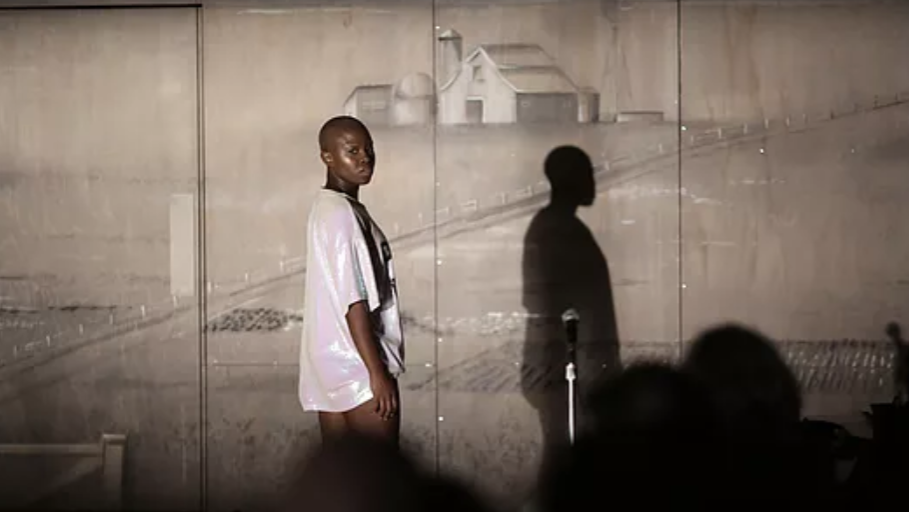
Gabrielle Hamilton in Daniel Fish’s Oklahoma! Photo by Teddy Wolff
JK: Speaking of intermission, what did you think of the reinvented dream ballet, which Fish moved from the end of Act 1 to the top of Act 2?
JK: I wanted to like it a lot. The solo dancer Gabrielle Hamilton, brown-skinned, head shaved, brows bleached, wearing an oversized white T-shirt with the words DREAM BABY DREAM, rushes out and electrifies the room with an extraordinary surge of dashing and galloping (choreography by John Heginbotham). She seems to channel Laurey’s repressed sexual energy and cool wariness at the same time, tempestuous and self-possessed, fire and ice all at once. The orchestra turns electric, pumping out the folksy score with fuzzy acid-rock amplification, and Hamilton’s shimmies and flatfoot stomping seem to marry African-dance codes to the suggestive pelvic-thrusting, horse-straddle moves that got Agnes De Mille in trouble with puritans back in 1943. At first, the ballet struck me as a terrific, brain-clearing, palate-cleansing collision of cultural references that forced us once again to reflect on all the people excluded from Rodgers and Hammerstein’s original idyll. The fictional world, gently fractured in Fish’s Act I, was blasted open even wider, leaving the sense that anything could happen.
Unfortunately, that promise was short-lived. Unlike De Mille’s dream ballet, which told a clear story about Laurey’s fears and desires through dancer counterparts for Curly and Jud, Heginbotham’s was completely non-narrative. The only re-entry to the action proper was a quick peek by the Curly and Jud actors out of doors near the end (Daunno and James Davis). By then the appearance of a dozen or so dancers from NYU Tisch joining Hamilton for some brief, underwhelming jogging around the stage had hopelessly muddled the identification of Hamilton and Laurey, and any other recognizable connections to the story. The ballet ended up feeling overlong and confusing.
JK: Some of Act 2 did rejigger the action, though. Were those parts not sufficiently “blasted open” for you?
JK: I liked them. In principle. The dispute between the farmers and the cowmen at the box social escalating to the point of reaching for the guns on the wall. The smooching sounds in the dark when Jud finally gets Laurey alone, after which he’s revealed with his pants unbuckled as they argue and she fires him (is she afraid of him or her own desire?). The wonderfully ambiguous climax where Jud, instead of falling on his knife accidentally after punching Curly at the wedding, hands Curly his own gun, which Curly shoots, spattering blood all over himself and Laurey in their spiffy wedding clothes. All this was refreshing and interesting. But the changes felt scattered and tentative in the end, inserted as anomalies into an act whose general tone and style were really the same as Act 1. Which is to say that the show as a whole was essentially bright and optimistic with sporadic hip touches, not thoroughly enough reconceived for its implied new, dark, critical through-line.
JK: Yeah, I guess you’re right. Didn’t you wish they’d put Aunt Eller in a Brett Kavanaugh mask for the last scene when she bullies the federal marshal into dropping his demand for a murder trial?
JK: This interview’s over.
This interview was originally posted on JonathanKalb.com on October 21, 2018, and has been reposted with permission.
This post was written by the author in their personal capacity.The opinions expressed in this article are the author’s own and do not reflect the view of The Theatre Times, their staff or collaborators.
This post was written by Jonathan Kalb.
The views expressed here belong to the author and do not necessarily reflect our views and opinions.

